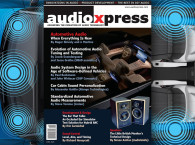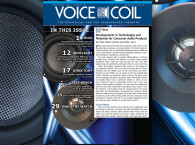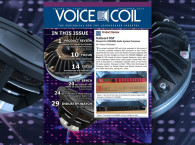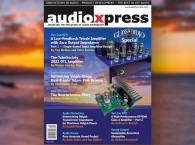 Our October issue features two excellent reviews, which are certain to excite both our readers professionally interested in audio innovations and design and those selfishly focused on discovering anything they can add to improve their personal listening experiences. We start with Gary Galo’s review of the recently introduced Bricasti Design M1 Dual Mono DAC - Deluxe Limited Edition. This improved state-of-the-art system from Bricasti is certainly a market reference in terms of design and implementation, including analog and digital circuit design, component selection, digital signal processing, power supplies, layout and construction - following a “no-cost-spared” approach that characterizes Bricasti since its foundation in 2004.
Our October issue features two excellent reviews, which are certain to excite both our readers professionally interested in audio innovations and design and those selfishly focused on discovering anything they can add to improve their personal listening experiences. We start with Gary Galo’s review of the recently introduced Bricasti Design M1 Dual Mono DAC - Deluxe Limited Edition. This improved state-of-the-art system from Bricasti is certainly a market reference in terms of design and implementation, including analog and digital circuit design, component selection, digital signal processing, power supplies, layout and construction - following a “no-cost-spared” approach that characterizes Bricasti since its foundation in 2004.Our second review might seem more unusual, but it certainly deserves attention from our readers. Oliver Masciarotte reviews the affordable but extremely useful MusicScope software, from a relative newcomer to the pro and consumer electronics software space, XiVero, from Germany. As Masciarotte details, “MusicScope is a cross-platform desktop application that addresses the need to know more about your music files. It plays digital audio in 10 different formats — from common to esoteric — and offers measurement and analysis functions tailored to professionals and modern audiophiles.” We have no doubt this useful tool with features not often found even in more professionally oriented software will become a recognized market reference. Oliver Masciarotte was fascinated by the amount of things he discovered and which he intends to explore further in future articles.
Thomas Perazella attended the 2016 Midwest Audiofest, invited by Parts Express to serve as one of the judges for its prestigious Speaker Design competition, which takes place every year at the company’s premises. Midwest Audiofest has been running for 12 years and draws a large crowd at its day-and-a-half event, which really is four events in one and offers something for everyone interested in audio. As Perazella writes, “The amount of heart shown by all the people at the show was outstanding. That included the sponsors of the show led by Parts Express plus 30 other vendors, the contestants at both the Speaker Design and MECA Auto Sound competitions, and all the Parts Express employees and the support companies that made it all possible.” In this Show Report he details his impressions of the Speaker Design contest, which surprised him with the diversity of approaches, the extremely high quality finishes, and the sound from many of the 45 entries.
audioXpress October features a great article by Christopher Paul, discussing an inexpensive, practically pre-assembled regulated filament supply, which he named “Reggie-Phil.” An article that not only details essential knowledge but enables anyone to build a useful project in practice. Why a Regulated Filament Supply? As our experienced author explains, “A regulator gets rid of the last audible vestige of power line hum, and its slow turn on minimizes the degradation of filaments. There is also something to be said for always operating at the filament design center values and eliminating any audible effects due to sudden changes in line voltage levels, such as those that occur when the compressor in your refrigerator or air conditioner cycles. And of course, a regulated or battery-powered source is a must for directly heated cathodes.”
A somehow related topic, in our regular Hollow-State Electronics column, Richard Honeycutt discusses Negative Feedback in Hollow-State Amplifiers: Its Design and Effects. His article offers a thorough understanding of the types and effects of feedback in electronic circuits, essential when designing hollow-state amplifiers.
We are certain our readers will enjoy also reading this month's interview with Matthew McGlynn, owner of Microphone-Parts.com and the creator of the most comprehensive microphone database at RecordingHacks.com. In this conversation, Matthew McGlynn explains how his interest for music and recording led him to explore the fascinating world of microphone design and construction, inspiring him to create a successful business for modifying and selling complete DIY microphone kits.
This month in Room Correction Revisited (Part 4), Ron Tipton tries out Audiolense 4.13 software. Following other computer programs to correct the way we hear the sound in a room, often called by the misnomer “room correction,” our author explores a higher-priced alternative but with features that may make the difference worthwhile. Audiolense, from Norway, comes in three Windows versions: Stereo, Surround, and XO.
Finally, our Sound Control column discusses the Electroacoustical/Acoustical Interface. In any sound system, the signal begins as an acoustical wave, then mics convert it to an electrical wave. Next, mixers, DSPs, and amplifiers mess around with the electrical wave for a while, and finally, speaker systems convert it back into an acoustical wave. The first and last steps (mics and speakers) are the electroacoustical ones. Richard Honeycutt focuses on the interface between the speaker and the acoustics of the venue into which it is playing, taking into account the sound’s function in a given venue.
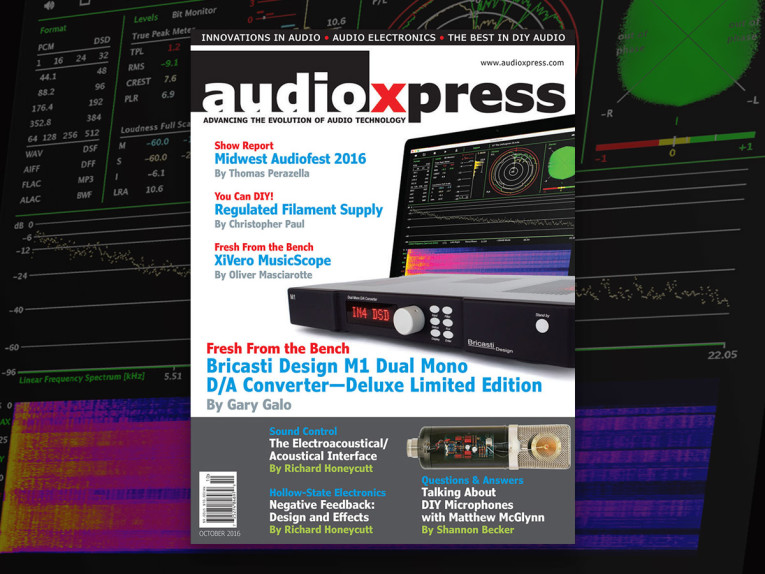
audioXpress October 2016 is now available. Access and download this edition now: www.gotomyxpress.com
Of course you can also subscribe here: www.audioxpress.com/page/audioXpress-Subscription-Services.html
And you can also buy a single printed issue or the complete audioXpress issue archive on USB at www.cc-webshop.com



